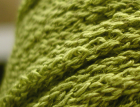|
|
SPUN SILK, NATURAL BLENDS

SILKWORMS, Photography © Linda N. Cortright,
Wild Fibers Magazine |
Silk fiber is the protein excretion of silkworms, spiders, or other insects. It is used by them to build their cocoons, webs, etc. The silk's amino acids composition is close to that of human skin. Pure silk is time-resistant, smooth unlike wool or cotton, hygienic, non-allergenic. As all luxury fibers, it is produced in very small quantities (less than 0.2% of overall textile fiber production).
In general, silk fiber can be divided in two categories: domesticated and wild. Domesticated silk is produced by the Bombyx mori moths, which feed on mulberry trees. Wild silk is usually considered as the excretion of an Antheraea moth fed on oak and other trees. India is the wold's largest producer of wild silk. Silk production, or Sericulture, has a long and colorful history. For more than two thousand years the Chinese kept the secret of silk - it was the most zealously guarded secret in world history. |
The key to understanding the great mystery and magic of silk, lies with one species: the blind, flightless moth, Bombyx mori. The silkworm of this particular moth produces a thread whose filament is smoother, finer and rounder than that of other silk moths. Today, a single silk cocoon can yield up to 1600 m of continuous filament (from 100 to 150 m - in ancient times). Silk yarn can be either releed or spun. Reeled silk, or filament silk, is the highest quality yarn, it is very white and shiny.
|
Mulberry Silk (Mullabary) is a very luxurious, domesticated silk fiber. It makes a very strong and lustrous yarn with a wonderful drape. Silk is very receptive to dyes and will retain its luster after dyeing. It can be either reeled or spun. Because of its long length, a yarn can be spun very fine if desired.
Tussah (Tassar) Silk is a thread from wild silkworms. There are many indigenous varieties of wild silk moths found in a number of different countries. Whether or not they are reared in the tropics, the leaves they eat contain tannin - the ingredient in tea that leaves a stain in your cup. The natural colour of Tussah silk is a warm honey beige, and "..silk produced by wild silkworms is stronger than steel.." Tussah is a coarse silk, and is mainly used for furnishings and interiors. Oak Tasar is a finer variety of Tussah silk. Golden Muga (or Assam silk) production is centered in Sualkuchi, and is a labor intensive industry. The detailed information about Muga and Eri Silks, including history and step-by-step production, is available in Fall 2009 issues of Wild Fibers Magazine. There are also Pat Silk, Spider Silk or Gossamer, Thai silk, Anjali Silk, Ghicha Silk, Katie Silk, Kosa silk, Rajshahi silk, etc. Art silks or " fake silks" are used in mass knitwear and yarn production: viscose, tencel, rayon and other varieties. More information about Sericulture: History of Silk » Silk of India » |

CHAZMIN © BURDA TRICOT Été 2015, designer: Clara Lana, yarn: Lang Stellina [55% Silk, 45% Cotton] |
 |
 |
 |
 |
 |
Did you know? Silk cocoon membrane responds to light, heat and moisture. It converts these energies to electrical signals. Essentially, it exhibits photo-electric and thermo-electric properties meaning that Silk cocoon works as a natural electro-magnetic sensor! - Reference: Soft magnetic memory of silk cocoon membrane, Article by M. Roy, A. Dubey, S. K. Singh, K. Bhargava at ResearchGate.net
MULBERRY AND COCOON (BOURETTE) SILK:
|
‹ BC Garn Eri Silk » ‹ Estelle Silk Harmony » ‹ Lana Gatto Silky |
‹ Lang Classic Silk ‹ Lotus Icelandic Silk » ‹ Lotus Silky Cashmere » |
‹ Lotus Silky Yak » ‹ Malabrigo Mora » |
Yarns with content of SILK ≤ 35%:
|
‹ Lana Gatto Silk Mohair Lux » ‹ Lana Grossa Merino Seta » ‹ Lang Mohair Luxe » |
‹ Lang Mohair Luxe Lamé » ‹ Lang Mohair Luxe Paillettes » ‹ Malabrigo Silkpaca » |
‹ Manos Fino Minis » |
 |
QUICK LINKS: |
☰ |
|
|
|
|
|
|
|
|
|
![Manos del Uruguay FINO MINI SKEINS [70% Merino Wool, 30% Silk]](images/Manos/Manos_FinoMinis.jpg)
|
|
|
|
|
|
|
|
|
|
All rights reserved. Website comments to webmaster.
Product Index - General Gifts Index - How to Order - Shipping - Giveaways - About - Contact
Information is updated daily.
Images, photography, and content are copyright protected.
Please do not use the visual content without our prior permission.